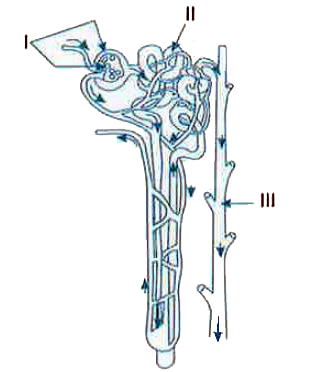You have been given structure of the basic structural unit of the Human kidney.
(a) What does the structure represent ?
(b) Identify I, II, III according to their function.
(c) Write in steps the process of urine formation.

Text Solution
(a) Nephron
(b) i. Bowman.s capsule, Glomerulus -Ultrafiltration
ii. Convoluted Tubule - Selective Reabsorption
iii. Collecting Duct - Secretion
(c) i. Ultrafiltration : The renal artery brings in impure, oxygenated blood into the Bowman.s capsule. It breaks down into a capillary network called glomerulus. The impurities alongwith smaller molecules which are of importance to the body get filtered out along with water from the blood.
ii. Selective reabsorption : The walls of convoluted tubules are permeable to water, glucose amino acids , etc. All these are selectively reabsorbed into the blood capillary around these tubules. As much as 90% of water is reabsorbed.
iii. Secretion : This last step completes the urine formation where cells closer to the collecting duct secrete ions .
|
Topper's Solved these Questions
- LIFE PROCESSESBOOK - U-LIKE SERIESCHAPTER - LIFE PROCESSESEXERCISE - Short answer questions
39 Videos
- HOW DO ORGANISMS REPRODUCE ?BOOK - U-LIKE SERIESCHAPTER - HOW DO ORGANISMS REPRODUCE ?EXERCISE - LONG ANSWER QUESTIONS
47 Videos
- OUR ENVIRONMENTBOOK - U-LIKE SERIESCHAPTER - OUR ENVIRONMENTEXERCISE - SHORT ANSWER QUESTIONS
34 Videos
Similar Questions
Knowledge Check
The basic functional and structural unit of human kidney is
or Loop of Henle is found inANephronBPyramidCNephridiaDHenle's loopStudy the given figure of Nucleosome (structural unit of chromatin). Identify its componental parts indicated by A,B and C
 AA- DNA,B- Non histone, C HistoneBA-RNA,B-Histone octamer, C-H1 histoneCA-DNA, B - H1 histone, C - Histone octamerDA - RNA, B -Non histone , C - Histone
AA- DNA,B- Non histone, C HistoneBA-RNA,B-Histone octamer, C-H1 histoneCA-DNA, B - H1 histone, C - Histone octamerDA - RNA, B -Non histone , C - HistoneThe given carbonate ion structures I, II and III represents:
 AHybrid structureBIsomeric structureCCanonical structureDDipole structure
AHybrid structureBIsomeric structureCCanonical structureDDipole structure
write the functions in brief in colum II approate to the structures given in column I.

View Solutionwrite the functions in brief in colum II approate to the structures given in column I.

View Solutionwrite the functions in brief in colum II approate to the structures given in column I.

View Solutionwrite the functions in brief in colum II approate to the structures given in column I.

View SolutionThe given structures I, II and III of carbonate ion represent

View Solution

 .
.